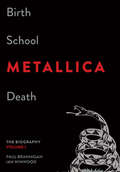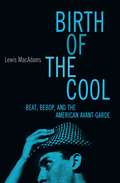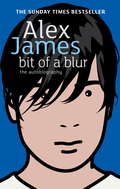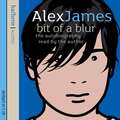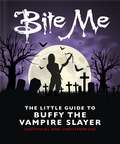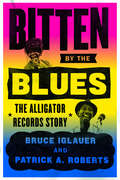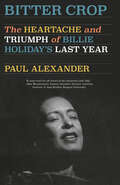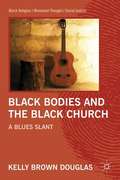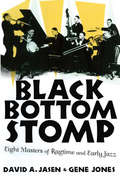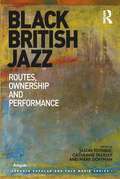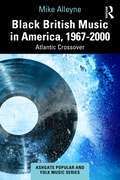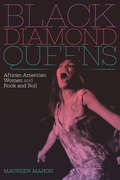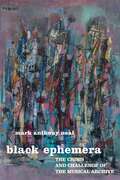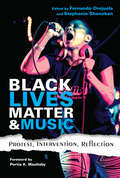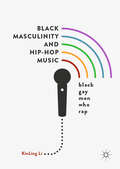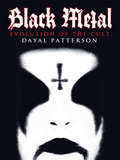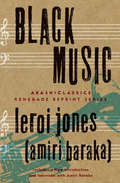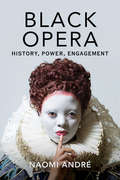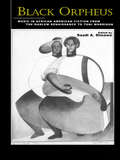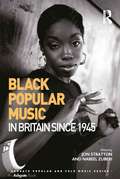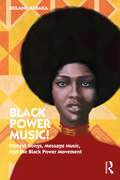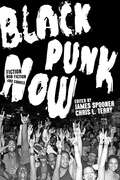- Table View
- List View
Birth School Metallica Death, Volume 1: The Biography
by Paul Brannigan Ian WinwoodThere has never been a hard rock band like Metallica. The California quartet has sold more than 100 million albums worldwide, won nine Grammy Awards, and had five consecutive albums hit number one on the Billboard charts. But Metallica's story, epic in scope, is a tale about much more than sales figures and critical acclaim, and their journey from scuzzy Los Angeles garages to the world's most storied stadiums has been dramatic and painful, their gigantic successes often shot through with tension, tragedy, loss, and controversy.Birth School Metallica Death is the definitive story of the most significant rock band since Led Zeppelin. Volume 1 covers the band's formation up to their breakthrough eponymous fifth album, aka "The Black Album." The intense and sometimes fraught relationship between aloof-yet-simmering singer, chief lyricist, and rhythm guitarist James Hetfield and the outspoken and ambitious drummer Lars Ulrich is the saga's emotional core. Their earliest years saw the release of three unimpeachable classics-Kill 'Em All, Ride the Lightning, and Master of Puppets-genre-defining masterpieces that took hard rock to a new level, both artistically and commercially. During these tumultuous times, the band persevered through line-up changes when guitarist Dave Mustaine was replaced by Kirk Hammet, and their bass player, the beloved Cliff Burton, was tragically killed in a bus crash while on tour in Europe.But it was the breakthrough of ...And Justice for All that rent the fabric of the mainstream, hitting the top of the charts without benefit of radio airplay or the then-crucial presence on MTV. And finally in 1991, with the release of their fifth studio album, nicknamed "The Black Album," Metallica hit the next level-five hit singles including their best-known songs "Enter Sandman" and "Nothing Else Matters"-and their first album atop the Billboard charts.In Birth School Metallica Death, veteran music journalists and Metallica confidants Paul Brannigan and Ian Winwood detail this meteoric rise to international fame in an epic saga of family, community, self-belief, the pursuit of dreams, and music that rocks. Told through first-hand interviews with the band and those closest to them, the story of Metallica's rise to the mainstream has never been so vividly documented.
Birth of the Cool
by Lewis MacadamsMiles Davis and Juliette Greco, Jackson Pollock and Jack Kerouac, Marlon Brando and Bob Dylan and William Burroughs. What do all these people have in common? Fame, of course, and undeniable talent. But most of all, they were cool. Birth of the Cool is a stunningly illustrated, brilliantly written cultural history of the American avant-garde in the 1940s and 1950s -- the decades in which cool was born. From intimate interviews with cool icons like poet Allen Ginsberg, bop saxophonist Jackie McLean, and Living Theatre cofounder Judith Malina, award-winning journalist and poet Lewis MacAdams extracts the essence of cool. Taking us inside the most influential and experimental art movements of the twentieth century -- from the Harlem jazz joints where Dizzy Gillespie and Charlie Parker invented bebop to the back room at Max's Kansas City when Andy Warhol was holding court to backstage at the Newport Folk Festival the night Bob Dylan went electric, from Surrealism to the Black Mountain School to Zen -- MacAdams traces the evolution of cool from the very fringes of society to the mainstream. Born of World War II, raised on atomic-age paranoia, cast out of the culture by the realities of racism and the insanity of the Cold War, cool is now, perversely, as conventional as you can get. Allen Ginsberg suited up for Gap ads. Volvo appropriated a phrase from Jack Kerouac's On the Road for its TV commercials. How one became the other is a terrific story, and it is presented here in a gorgeous package, rich with the coolest photographs of the black-and-white era from Robert Doisneau, Henri Cartier-Bresson, Man Ray, and many others. Drawing a direct line between Lester Young wearing his pork-pie hat and his crepe-sole shoes staring out his hotel window at Birdland to the author's three-year-old daughter saying "cool" while watching a Scooby-Doo cartoon at the cusp of a new millennium, Birth of the Cool is a cool book about a hot subject...maybe even the coolest book ever.
Bit Of A Blur: The Autobiography
by Alex JamesI was the Fool-king of Soho and the number-one slag in the Groucho Club, the second drunkest member of the world's drunkest band. This was no disaster, though. It was a dream coming true.'For Alex James, music had always been a door to a more eventful life. But as bass player of Blur - one of the most successful British bands of all time - his journey was more exciting and extreme than he could ever have predicted. In Bit of a Blur he chronicles his journey from a slug-infested flat in Camberwell to a world of screaming fans and private jets - and his eventual search to find meaning and happiness (and, perhaps most importantly, the perfect cheese), in an increasingly surreal world.
Bit Of A Blur: The Autobiography
by Alex JamesFor Alex James, music had always been a door to a more exciting life: a way to travel, meet new people and, hopefully, pick up girls. But as bass player of Blur - one of the most successful British bands of all time - his journey was more exciting and extreme than he could ever have predicted. Success catapulted him from a slug-infested squat in Camberwell to a world of private jets and world-class restaurants. As 'the second drunkest member of the world's drunkest band' life was always chaotic, but Alex James retained a boundless enthusiasm and curiosity at odds with his hedonistic lifestyle. From nights in the Groucho with Damien Hirst, to dancing to Sister Sledge with Bjork, to being bitten on the nose by the lead singer of Iron Maiden, he offers a fascinating and hilarious insight into the world of celebrity. At its heart, however, A BIT OF A BLUR is the picaresque tale of one man's search to find meaning and happiness in an increasingly surreal world. Pleasingly unrepentant but nonetheless a reformed man, Alex James is the perfect chronicler of his generation - witty, frank and brimming with joie de vivre. A BIT OF A BLUR is as charming, funny and deliciously disreputable as its author.
Bit of a Blur: The Autobiography
by Alex JamesI was the Fool-king of Soho and the number-one slag in the Groucho Club, the second drunkest member of the world's drunkest band. This was no disaster, though. It was a dream coming true.'For Alex James, music had always been a door to a more eventful life. But as bass player of Blur - one of the most successful British bands of all time - his journey was more exciting and extreme than he could ever have predicted. In Bit of a Blur he chronicles his journey from a slug-infested flat in Camberwell to a world of screaming fans and private jets - and his eventual search to find meaning and happiness (and, perhaps most importantly, the perfect cheese), in an increasingly surreal world.
Bite Me: The Little Guide to Buffy the Vampire Slayer
by Orange Hippo!"I'm Buffy, the vampire slayer. And you are?"A prestige show that was ahead of its time, Buffy the Vampire Slayer brought vampires back into the mainstream and made stars of its cast, and its impact has lasted long after the show's end. With its unique blend of high-school drama, witty banter and the supernatural, Buffy the Vampire Slayer became known for ushering in golden age of television. With a devoted cult following and a growing new audience, Buffy remains a cultural icon.Reminisce some of the most iconic quotes you've ever heard in your life (or "unlife") in The Little Guide to Buffy the Vampire Slayer, filled with quips and facts about the adventures of the famous slayer and her friends against the forces of darkness."In every generation, there is a chosen one. She alone shall stand against the vampires, demons and forces of darkness. She is the slayer."Spike's trademark coat cost $2,000 from a top fashion store. It was then run over repeatedly by a truck to give it that distressed look.
Bite Me: The Little Guide to Buffy the Vampire Slayer
by Orange Hippo!"I'm Buffy, the vampire slayer. And you are?"A prestige show that was ahead of its time, Buffy the Vampire Slayer brought vampires back into the mainstream and made stars of its cast, and its impact has lasted long after the show's end. With its unique blend of high-school drama, witty banter and the supernatural, Buffy the Vampire Slayer became known for ushering in golden age of television. With a devoted cult following and a growing new audience, Buffy remains a cultural icon.Reminisce some of the most iconic quotes you've ever heard in your life (or "unlife") in The Little Guide to Buffy the Vampire Slayer, filled with quips and facts about the adventures of the famous slayer and her friends against the forces of darkness."In every generation, there is a chosen one. She alone shall stand against the vampires, demons and forces of darkness. She is the slayer."Spike's trademark coat cost $2,000 from a top fashion store. It was then run over repeatedly by a truck to give it that distressed look.
Bitten by the Blues: The Alligator Records Story (Chicago Visions and Revisions)
by Bruce Iglauer Patrick A. RobertsIt started with the searing sound of a slide careening up the neck of an electric guitar. In 1970, twenty-three-year-old Bruce Iglauer walked into Florence’s Lounge, in the heart of Chicago’s South Side, and was overwhelmed by the joyous, raw Chicago blues of Hound Dog Taylor and the HouseRockers. A year later, Iglauer produced Hound Dog’s debut album in eight hours and pressed a thousand copies, the most he could afford. From that one album grew Alligator Records, the largest independent blues record label in the world. Bitten by the Blues is Iglauer’s memoir of a life immersed in the blues—and the business of the blues. No one person was present at the creation of more great contemporary blues music than Iglauer: he produced albums by Koko Taylor, Albert Collins, Professor Longhair, Johnny Winter, Lonnie Mack, Son Seals, Roy Buchanan, Shemekia Copeland, and many other major figures. In this book, Iglauer takes us behind the scenes, offering unforgettable stories of those charismatic musicians and classic sessions, delivering an intimate and unvarnished look at what it’s like to work with the greats of the blues. It’s a vivid portrait of some of the extraordinary musicians and larger-than-life personalities who brought America’s music to life in the clubs of Chicago’s South and West Sides. Bitten by the Blues is also an expansive history of half a century of blues in Chicago and around the world, tracing the blues recording business through massive transitions, as a genre of music originally created by and for black southerners adapted to an influx of white fans and musicians and found a worldwide audience. Most of the smoky bars and packed clubs that fostered the Chicago blues scene have long since disappeared. But their soul lives on, and so does their sound. As real and audacious as the music that shaped it, Bitten by the Blues is a raucous journey through the world of Genuine Houserockin’ Music.
Bitter Crop: The Heartache and Triumph of Billie Holiday's Last Year
by Paul AlexanderA revelatory look at the tumultuous life of a jazz legend and American cultural icon&“A book written as only one artist could view another, with insight and sincere compassion.&” —Sandra Cisneros, best-selling author of Woman Without ShameIn the first biography of Billie Holiday in more than two decades, Paul Alexander—author of heralded lives of Sylvia Plath and J. D. Salinger—gives us an unconventional portrait of arguably America&’s most eminent jazz singer. He shrewdly focuses on the last year of her life—with relevant flashbacks to provide context—to evoke and examine the persistent magnificence of Holiday&’s artistry when it was supposed to have declined, in the wake of her drug abuse, relationships with violent men, and run-ins with the law.During her lifetime and after her death, Billie Holiday was often depicted as a down-on-her-luck junkie severely lacking in self-esteem. Relying on interviews with people who knew her, and new material unearthed in private collections and institutional archives, Bitter Crop—a reference to the last two words of Strange Fruit, her moving song about lynching—limns Holiday as a powerful, ambitious woman who overcame her flaws to triumph as a vital figure of American popular music.
Black Bodies and the Black Church
by Kelly Brown DouglasBlues is absolutely vital to black theological reflection and to the black church's existence. In Black Bodies and the Black Church , author Kelly Douglas Brown develops a blues crossroad theology, which allows the black church to remain true to itself and relevant in black lives.
Black Bottom Stomp: Eight Masters of Ragtime and Early Jazz
by David A. Jasen Gene JonesBlack Bottom Stomp tells the compelling stories of the lives and times of nine seminal figures in American music history, including Scott Joplin, Louis Armstrong, and Jelly Roll Morton.
Black British Jazz: Routes, Ownership and Performance (Ashgate Popular and Folk Music Series)
by Jason Toynbee Catherine TackleyBlack British musicians have been making jazz since around 1920 when the genre first arrived in Britain. This groundbreaking book reveals their hidden history and major contribution to the development of jazz in the UK. More than this, though, the chapters show the importance of black British jazz in terms of musical hybridity and the cultural significance of race. Decades before Steel Pulse, Soul II Soul, or Dizzee Rascal pushed their way into the mainstream, black British musicians were playing jazz in venues up and down the country from dance halls to tiny clubs. In an important sense, then, black British jazz demonstrates the crucial importance of musical migration in the musical history of the nation, and the links between popular and avant-garde forms. But the volume also provides a case study in how music of the African diaspora reverberates around the world, beyond the shores of the USA - the engine-house of global black music. As such it will engage scholars of music and cultural studies not only in Britain, but across the world.
Black British Music in America, 1967–2000: Atlantic Crossover (Ashgate Popular and Folk Music Series)
by Mike AlleyneBlack British Music in America 1967–2000: Atlantic Crossover historically examines musical and cultural relationships through popular music recordings, exploring the transatlantic journeys via academic, critical, and commercial reception of the music. It addresses an overlooked area of Black popular music, investigating the fluctuating fortunes of artists and the contradictions of exporting such recordings to America.Examining a complex history spanning the last four decades of the twentieth century, the author reveals the chronologies and the recording industry circumstances shaping the presence of Black British music in America. Readers will discover the conditions under which key recordings were made and released, through detailed analysis and new interviews with participating producers and artists. Including exploration of chart histories, this book also dissects the content of the recordings, uncovering the elements that made many of them successful.Black British Music in America 1967–2000 will interest all those who study popular music, cultural studies, and music production, as well as popular music listeners.
Black Diamond Queens: African American Women and Rock and Roll (Refiguring American Music)
by Maureen MahonAfrican American women have played a pivotal part in rock and roll—from laying its foundations and singing chart-topping hits to influencing some of the genre's most iconic acts. Despite this, black women's importance to the music's history has been diminished by narratives of rock as a mostly white male enterprise. In Black Diamond Queens, Maureen Mahon draws on recordings, press coverage, archival materials, and interviews to document the history of African American women in rock and roll between the 1950s and the 1980s. Mahon details the musical contributions and cultural impact of Big Mama Thornton, LaVern Baker, Betty Davis, Tina Turner, Merry Clayton, Labelle, the Shirelles, and others, demonstrating how dominant views of gender, race, sexuality, and genre affected their careers. By uncovering this hidden history of black women in rock and roll, Mahon reveals a powerful sonic legacy that continues to reverberate into the twenty-first century.
Black Diva of the Thirties: The Life of Ruby Elzy (Willie Morris Books in Memoir and Biography)
by David E. WeaverWhile undergoing routine surgery to remove a benign tumor, Ruby Elzy died. She was only thirty-five. Had she lived, she would have been one of the first Black artists to appear in grand opera. Although now in the shadows, she was a shining star in her day. She entertained Eleanor Roosevelt in the White House. She was Paul Robeson's leading lady in the movie version of The Emperor Jones. She starred in Birth of the Blues opposite Bing Crosby and Mary Martin. She sang at Harlem's Apollo Theater and in the Hollywood Bowl. Her remarkable soprano voice was known to millions over the radio. She was personally chosen by George Gershwin to create one of the leading roles in his masterpiece, that of Serena in the original production of Porgy and Bess. Her signature song was the vocally demanding “My Man's Gone Now.” From obscurity she had risen to great heights. Ruby Pearl Elzy (1908-1943) was born in abject poverty in Pontotoc, Mississippi. Her father abandoned the family when she was five, leaving her mother, a strong, devout woman, to raise four small children. Ruby first sang publicly at the age of four and even in childhood dreamed of a career on the stage. Good fortune struck when a visiting professor, overwhelmed upon hearing her beautiful voice at Rust College in Mississippi, arranged for her to study music at Ohio State University. Later, on a Rosenwald Fellowship, she enrolled at the Juilliard School in New York City. After more than eight hundred performances in Porgy and Bess, she set her sights on a huge goal, to sing in grand opera. She was at the peak of her form. While she was preparing for her debut in the title role of Verdi's Aida, tragedy struck. During her brief career, Ruby Elzy was in the top tier of American sopranos and a precursor who paved a way for Leontyne Price, Jessye Norman, Kathleen Battle, and other black divas of the operatic stage. This biography acknowledges her exceptional talent, recognizes her contribution to American music, and tells her tragic yet inspiring story.
Black Ephemera: The Crisis and Challenge of the Musical Archive
by Mark Anthony NealPROSE Award- Music and Performing Arts Category WinnerA framework for understanding the deep archive of Black performance in the digital eraIn an era of Big Data and algorithms, our easy access to the archive of contemporary and historical Blackness is unprecedented. That iterations of Black visual art, such as Bert Williams’s 1916 silent film short “A Natural Born Gambler” or the performances of Josephine Baker from the 1920s, are merely a quick YouTube search away has transformed how scholars teach and research Black performance.While Black Ephemera celebrates this new access, it also questions the crisis and the challenge of the Black musical archive in a moment when Black American culture has become a global export. Using music and sound as its primary texts, Black Ephemera argues that the cultural DNA of Black America has become obscured in the transformation from analog to digital. Through a cross-reading of the relationship between the digital era and culture produced in the pre-digital era, Neal argues that Black music has itself been reduced to ephemera, at best, and at worst to the background sounds of the continued exploitation and commodification of Black culture. The crisis and challenges of Black archives are not simply questions of knowledge, but of how knowledge moves and manifests itself within Blackness that is obscure, ephemeral, fugitive, precarious, fluid, and increasingly digital. Black Ephemera is a reminder that for every great leap forward there is a necessary return to the archive. Through this work, Neal offers a new framework for thinking about Black culture in the digital world.
Black Lives Matter and Music: Protest, Intervention, Reflection (Activist Encounters in Folklore and Ethnomusicology)
by Portia K. Maultsby Stephanie Shonekan Fernando OrejuelaMusic has always been integral to the Black Lives Matter movement in the United States, with songs such as Kendrick Lamar’s "Alright," J. Cole’s "Be Free," D’Angelo and the Vanguard's "The Charade," The Game’s "Don’t Shoot," Janelle Monae’s "Hell You Talmbout," Usher’s "Chains," and many others serving as unofficial anthems and soundtracks for members and allies of the movement. In this collection of critical studies, contributors draw from ethnographic research and personal encounters to illustrate how scholarly research of, approaches to, and teaching about the role of music in the Black Lives Matter movement can contribute to public awareness of the social, economic, political, scientific, and other forms of injustices in our society. Each chapter in Black Lives Matter and Music focuses on a particular case study, with the goal to inspire and facilitate productive dialogues among scholars, students, and the communities we study. From nuanced snapshots of how African American musical genres have flourished in different cities and the role of these genres in local activism, to explorations of musical pedagogy on the American college campus, readers will be challenged to think of how activism and social justice work might appear in American higher education and in academic research. Black Lives Matter and Music provokes us to examine how we teach, how we conduct research, and ultimately, how we should think about the ways that black struggle, liberation, and identity have evolved in the United States and around the world.
Black Masculinity and Hip-Hop Music: Black Gay Men Who Rap
by Xinling LiThis book offers an interdisciplinary study of hip-hop music written and performed by rappers who happen to be out black gay men. It examines the storytelling mechanisms of gay themed lyrics, and how these form protests and become enabling tools for (black) gay men to discuss issues such as living on the down-low and HIV/AIDS. It considers how the biased promotion of feminised gay male artists/characters in mainstream entertainment industry has rendered masculinity an exclusively male heterosexual property, providing a representational framework for men to identify with a form of “homosexual masculinity” – one that is constructed without having to either victimise anything feminine or necessarily convert to femininity. The book makes a strong case that it is possible for individuals (like gay rappers) to perform masculinity against masculinity, and open up a new way of striving for gender equality.
Black Metal
by Dayal PattersonFeaturing a wealth of new interviews with the genre's most central figures, Black Metal: Evolution of the Cult offers the most comprehensive guide yet to the most controversial form of extreme metal. From the pioneers of the early '80s to its fiery rebirth in Scandinavia through to today's diverse groups, this epic analysis captures the movement's development in unparalleled depth.
Black Music (Akashi Classics: Renegade Reprint Series)
by LeRoi JonesThe essential collection of jazz writing by the celebrated poet and author of Blues People—reissued with a new introduction by the author. In the 1960s, LeRoi Jones—who would later be known as Amiri Baraka—was a pioneering jazz critic, articulating in real time the incredible transformations of the form taking place in the clubs and coffee houses of New York City. In Black Music, he sheds light on the brilliant young jazz musicians of the day: John Coltrane, Thelonious Monk, Miles Davis, Ornette Coleman, Cecil Taylor, Archie Shepp, Sun Ra, and others. Combining firsthand immediacy with wide-ranging erudition, Black Music articulates the complexities of modern jazz while also sharing insights on the nature of jazz criticism, the creative process, and the development of a new way forward for black artists. This rich and vital collection is comprised of essays, reviews, interviews, liner notes, musical analyses, and personal impressions from 1959–1967. &“In Black Music, Baraka wrote with ecstasy—highly informed and intricate—about ecstatically complex music.&”—Richard Brody, The New Yorker
Black Opera: History, Power, Engagement
by Naomi AndreFrom classic films like Carmen Jones to contemporary works like The Diary of Sally Hemmings and U-Carmen eKhayelitsa, American and South African artists and composers have used opera to reclaim black people's place in history. Naomi André draws on the experiences of performers and audiences to explore this music's resonance with today's listeners. Interacting with creators and performers, as well as with the works themselves, André reveals how black opera unearths suppressed truths. These truths provoke complex, if uncomfortable, reconsideration of racial, gender, sexual, and other oppressive ideologies. Opera, in turn, operates as a cultural and political force that employs an immense, transformative power to represent or even liberate. Viewing opera as a fertile site for critical inquiry, political activism, and social change, Black Opera lays the foundation for innovative new approaches to applied scholarship.
Black Orpheus: Music in African American Fiction from the Harlem Renaissance to Toni Morrison (Border Crossings #Vol. 9)
by Saadi A. SimaweThe legendary Greek figure Orpheus was said to have possessed magical powers capable of moving all living and inanimate things through the sound of his lyre and voice. Over time, the Orphic theme has come to indicate the power of music to unsettle, subvert, and ultimately bring down oppressive realities in order to liberate the soul and expand human life without limits. The liberating effect of music has been a particularly important theme in twentieth-century African American literature. The nine original essays in Black Orpheus examines the Orphic theme in the fiction of such African American writers as Jean Toomer, Langston Hughes, Claude McKay, James Baldwin, Nathaniel Mackey, Sherley Anne Williams, Ann Petry, Ntozake Shange, Alice Walker, Gayl Jones, and Toni Morrison. The authors discussed in this volume depict music as a mystical, shamanistic, and spiritual power that can miraculously transform the realities of the soul and of the world. Here, the musician uses his or her music as a weapon to shield and protect his or her spirituality. Written by scholars of English, music, women’s studies, American studies, cultural theory, and black and Africana studies, the essays in this interdisciplinary collection ultimately explore the thematic, linguistic structural presence of music in twentieth-century African American fiction.
Black Popular Music in Britain Since 1945 (Ashgate Popular and Folk Music Series)
by Jon Stratton Nabeel ZuberiBlack Popular Music in Britain Since 1945 provides the first broad scholarly discussion of this music since 1990. The book critically examines key moments in the history of black British popular music from 1940s jazz to 1970s soul and reggae, 1990s Jungle and the sounds of Dubstep and Grime that have echoed through the 2000s. While the book offers a history it also discusses the ways black musics in Britain have intersected with the politics of race and class, multiculturalism, gender and sexuality, and debates about media and technology. Contributors examine the impact of the local, the ways that black music in Birmingham, Bristol, Liverpool, Manchester and London evolved differently and how black popular music in Britain has always developed in complex interaction with the dominant British popular music tradition. This tradition has its own histories located in folk music, music hall and a constant engagement, since the nineteenth century, with American popular music, itself a dynamic mixing of African-American, Latin American and other musics. The ideas that run through various chapters form connecting narratives that challenge dominant understandings of black popular music in Britain and will be essential reading for those interested in Popular Music Studies, Black British Studies and Cultural Studies.
Black Power Music!: Protest Songs, Message Music, and the Black Power Movement
by Reiland RabakaBlack Power Music! Protest Songs, Message Music, and the Black Power Movement critically explores the soundtracks of the Black Power Movement as forms of "movement music." That is to say, much of classic Motown, soul, and funk music often mirrored and served as mouthpieces for the views and values, as well as the aspirations and frustrations, of the Black Power Movement. Black Power Music! is also about the intense interconnections between Black popular culture and Black political culture, both before and after the Black Power Movement, and the ways in which the Black Power Movement in many senses symbolizes the culmination of centuries of African American politics creatively combined with, and ingeniously conveyed through, African American music. Consequently, the term "Black Power music" can be seen as a code word for African American protest songs and message music between 1965 and 1975. "Black Power music" is a new concept that captures and conveys the fact that the majority of the messages in Black popular music between 1965 and 1975 seem to have been missed by most people who were not actively involved in, or in some significant way associated with, the Black Power Movement.
Black Punk Now
by James Spooner and Chris L. TerryA canonizing, bold, and urgent anthology setting a new precedent for Black Punk Lit, created by generations of Black punks—featuring both new voices and those from the not-so-recent pastBlack Punk Now is an anthology of contemporary nonfiction, fiction, illustrations, and comics that collectively describe punk today and give punks—especially the Black ones—a wider frame of reference. It shows all of the strains, styles, and identities of Black punk that are thriving, and gives newcomers to the scene more chances to see themselves.Curated from the perspective of Black writers with connections to the world of punk, the collection mixes media as well as generations, creating a new reference point for music-lovers, readers, and historians by capturing the present and looking towards the future. With strong visual elements integrated throughout, this smart, intimate collection is demonstrative of punk by being punk itself: underground, rebellious, aesthetic but not static—working to decenter whiteness by prioritizing other perspectives.Edited by graphic novelist and filmmaker James Spooner, and author Chris L. Terry, contributors to the collection include critic Hanif Abdurraqib and Mars Dixon, conversations with Brontez Purnell, and a roundtable of all femme festival organizers.
